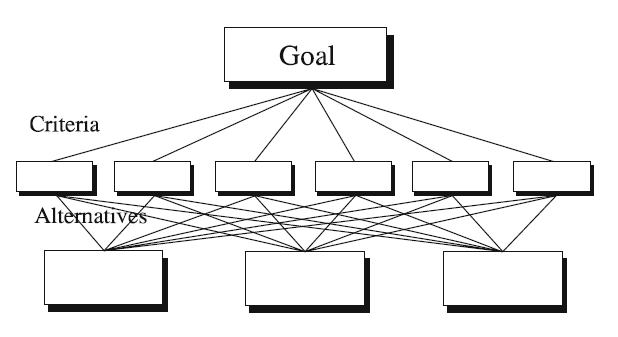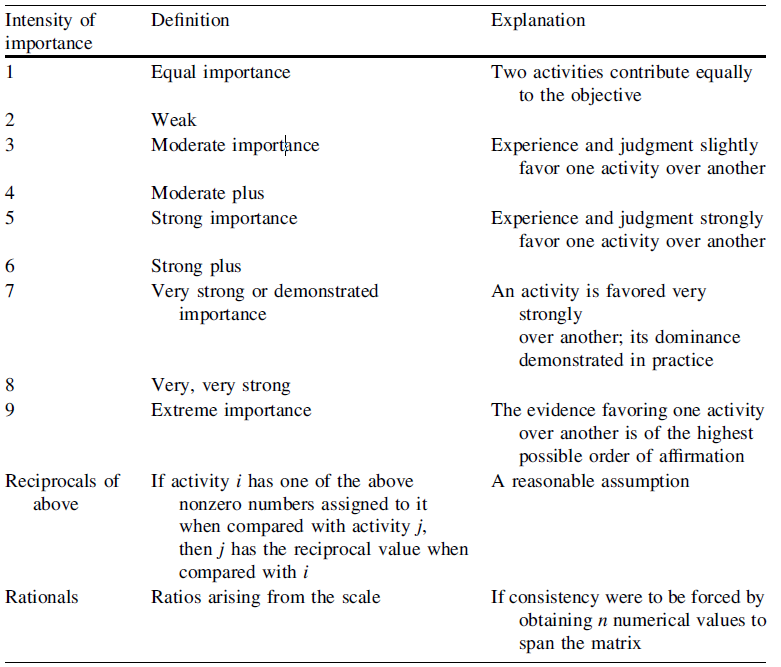AHP as a Decision Making Tool in Projects, Programs and Portfolios
In both project, program and portfolio management decision has to be made all the time. Because of this there's a huge potential to optimize the time spend on decision making by standardizing it. Standardizing the decision making process also minimizes biased and emotional decisions. So it makes sense to standardize decision making, but how should it be done? It should be done by using analytic hierarchy process also known as AHP. AHP is a structured way of organizing complex decision. It’s based on math and psychology and it uses a scoring system. In this way it reminds of the decision matrix but the score is rated to make sure that no biased decision can be made. To use AHP the decision has to be formulated into a hierarchy with a goal, certain criteria and some alternatives to choose from.
Contents |
History
While directing research projects for United States Arms Control and Disarmament Agency in 1960’s Thomas L. Saaty worked with some of the world leading lawyers, economists and game theorists advising on which weapon to procure, keep and scrap. Even though working with some of the world leading academics Thomas L. Saaty wasn’t satisfied with the results gained throughout the different projects. He found that the models where to abstract to give a particular answer. They also had problems addressing the diverse concerns of the scientists.
Years later Thomas L. Saaty was still trouble by these issues. In an article from 1986 [1] he came up with the axioms for the AHP as a solution to his problem. AHP is a mathematical well-defined structure consisting of matrices and their associated right-eigenvector’s ability to generate true or approximate weights. The methodology compares criteria, or alternatives in a pairwise mode with the use of a fundamental scale.
Relevance for Project, Program and Portfolio Management
Both in projects, programs and portfolios decisions has to made on a daily basis. These decisions are often multi criteria decisions, which has to be made on an objective manor. AHP is ideal for this by its structure, simplicity and ease of use. What makes AHP even more relevant how it eliminates subjective and biased input with the eigenvectors.
The Analytic Hierarchy Process
The AHP methodology is based on three primary functions: Structuring complexity, measurements and synthesis. The basic human way of structuring complexity is by hierarchy, so to make the methodology simple this is how problems are structured. Hierarchical-based methodology has to use ratio-scale priorities for measurements. The reason for this is that the priority of an element at any level of the hierarchy is determined by multiplying the priorities of the elements in that level by the priorities of the parent element[2]. When a multi criteria decision is made it often synthesizes over more dimensions than what the human intuition can handle. Therefor the last function of the AHP methodology is to synthesizes all the dimensions of the decision.
According to DSS Resources these three primary functions leads to the following definition:
From this definition 6 steps can be derived for the AHP methodology:
- Define objective
- Structure the multiple choice criteria into a hierarchy
- Make a pair wise comparison of elements in each group
- Calculate weighting and consistency ratio
- Evaluate alternatives according to weighting
- Get ranking
Application
To apply the AHP methodology the 6 steps has to be used in order. The first times AHP is used it will take a lot of time, but when it has been used several times it’s really easy to apply and use.
Step 1: Define objective
Here the goal for the multi criteria decision should be set. An example of an objective for a building project could be the selection of a subcontractor for installing windows.
Step 2: Hierarchy
The simplest way of structuring a decision problem is by a hierarchy. The goal of the decision being the top level. The criteria of the decision being the second. The third level are the different alternatives. This way of structuring the decision problem is illustrated in figure 1[3]:

The goal is what you want to obtain from the decision. It could be to choose a contractor for your building project. Then the criteria are the different demands you have to the given contractor, it could be living up to a specific ISO-standard for labour security. The alternatives would then be the different contractors you have in mind.
Step 3: Pair wise comparison
For the pair wise comparison of the scoring system the fundamental scale is used. This scale rank the criteria’s level of importance compared to the other criteria on a scale from 1-9. Where 1 is equally importance and 9 is that the criteria looked at is extremely important. The scale is given below [3]:
The scoring is done in a matrix. To illustrate the pairwise comparison an example is used. The goal is the purchase of a new computer. 3 alternatives are found: A Lenovo, a sony and a mac. The budget for the purchase is fixed so the criteria for ranking the alternatives will be: Battery time, processing power and durability. The scoring of the 3 alternatives are now done in a matrix:
| Pairwise comparison of computers with regards to battery time | |||||
|---|---|---|---|---|---|
| Lenovo | Sony | Mac | |||
| Lenovo | 1 | 5 | 3 | ||
| Sony | 1/5 | 1 | 1/2 | ||
| Mac | 1/3 | 2 | 1 | ||
| Sum | 1,53 | 8 | 4,5 | ||
This is process is then done for the processing power and durability. This is the pairwise comparison.
Step 4: Weighting and consistency
To calculate the consistency, the average random consistency index is used. But before this is done, the matrix has to be normalized and the eigenvector has to be found. The vector is normalized by dividing each cell in the column with the total sum of the column. We continue with the computer example:
| Normalized pairwise comparison of computers with regards to battery time | |||||
|---|---|---|---|---|---|
| Lenovo | Sony | Mac | |||
| Lenovo | 1/1,53 = 0,65 | 5/8 = 0,63 | 3/4,5 = 0,67 | ||
| Sony | (1/5)/1,53 = 0,13 | 1/8 = 0,13 | (1/2)/4,5 = 0,11 | ||
| Mac | (1/3)/1,53 = 0,22 | 2/8 = 0,25 | 1/4,5 = 0,22 | ||
Average random consistency index is used for the creation of
Step 5: Evaluation of the alternatives
Step 6: The ranking
Examples on the use of AHP
Criticism
References
- ↑ Saaty, T. L. (1986). Axiomatic Foundation of the Analytic Hierarchy Process. Management Science, 32(7). http://doi.org/10.2307/2631765
- ↑ Forman, E. H. (2001). The Analytic Hierarchy Process: An Exposition. Operations Research, 49(4). http://doi.org/10.2307/3088581
- ↑ 3.0 3.1 Saaty, T. L., & Vargas, L. G. (2012). Models, Methods, Concepts & Applications of the Analytic Hierarchy Process (Vol. 175). Boston, MA: Springer US. http://doi.org/10.1007/978-1-4614-3597-6
